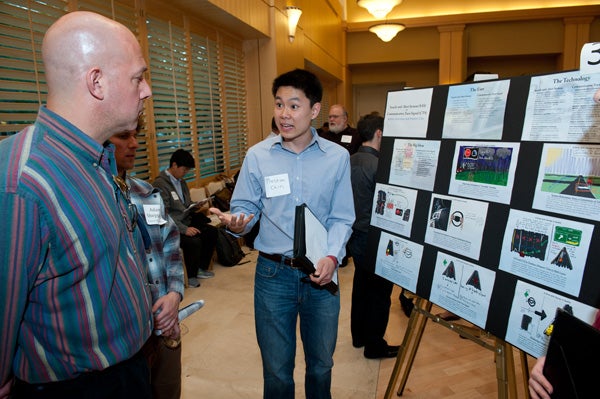|
March 18, 2013
Stanford students present visions for the future of driving
Professor Clifford Nass' communication students propose new driving technologies at the first Big Idea Festival for Automotive Interfaces. Among the concepts are a gesture-based camera system to replace steering wheels and technology that would allow you to drive your car from your couch. By Bjorn Carey

Preston Chin presents the Search/Alert Communicative Turn Signal system at the Big Idea Festival for Automotive Interfaces. Conceived with fellow student Bobby Gonzales (not pictured), the system would tell drivers when it's safe to change lanes. (Photo: Steve Castillo / Courtesy of Stanford University)
The car of the future won't have a steering wheel or gas and brake pedals. If that sounds weird, just wait until you drive it around the neighborhood without leaving the comfort of your couch.
These were a few of the concepts presented by 65 groups of students at the first Big Idea Festival for Automotive Interfaces, an event that showcased technologies dreamed up by the 140 students in communication Professor Clifford Nass' course Computers and Interfaces.
The event, which was co-sponsored by Stanford's CHIMe Lab, CARS, mediaX and Revs programs, drew 220 guests from around the world. In Nass' welcoming remarks, he encouraged guests, many of whom work in the automotive and tech industries, to look past the technical challenges of the storyboarded concepts.
"Instead, engage the students, and yourself, by asking: 'How can I take these big ideas and leverage them for my own products, services and understanding?'" he said.
Several of the student groups explored ways to integrate social media into the driving experience. One concept, hatched by Matt Bettonville, Mark Diaz and Matt Lathrop, would link social media information on each passenger's smartphone to create a group model of the passengers' preferences, perhaps for music or food.
For instance, the app would sift through the group's music playlists and "likes" on Facebook profiles to suggest a radio station that everyone in the car would enjoy. Similarly, it would scan the users' Yelp profiles, find that they all like hamburgers, and suggest a nearby burger joint.
"Riding in the car is a unique social experience, in that you're all stuck in the car for a while and you have to get along, and yet one person is usually in control," Bettonville said. "Your phone knows more and more about your preferences and activities, and it's easy to make a good guess about what you like. We thought this would be a good way to make group decisions."
Manvi Mahana was inspired by the Microsoft Kinect gesture-based gaming system to create GestUR Car, a system that would swap the steering wheel and pedals for a camera pointed at the driver. The system would capture specific hand gestures and convert those signals into driving actions.
For example, snap your fingers to start the car, and raise your hand up or down to control the speed. Simply point your index finger in the direction you want to turn, and pull your hand toward your body to hit the brakes. Mahana is undecided whether she will further develop GestUR Car, but she plans to design other gesture-controlled apps in the near future.
Meanwhile, a technology called 3POV would keep the steering wheel but do away with the windshield. Or, rather, replace it with a videogame screen. Phil Brady and Tianda Deng noted that in racing videogames, players typically choose a third-person camera angle – a viewpoint from above and behind the car – over a more realistic cockpit view.
They reasoned that gamers choose this view because it improves situational awareness by making it easier to see the car's surroundings, so why not bring it to the real world? Their concept calls for mounting two 360-degree cameras to the car's roof and projecting images onto the windshield.
The technology is readily available to build the system, they said, and it could appeal to younger and inexperienced drivers, or to people who often lose other cars in their blind spot. The system also could be rigged, they said, so that you could drive your car while sitting at home.
Several proposed technologies aimed to make driving safer by giving the driver better traffic information. The Perfect Backseat Driver, presented by Alison Epstein, Allison Otis and Blake Lueders, aims to give drivers a local's knowledge when driving in a new town. For example, users would upload locations of particularly dangerous intersections to a database. This data would feed into your car's GPS navigation system and advise you to make sure you look twice before crossing the road.
Another system, called the Search/Alert Communicative Turn Signal, would anticipate a driver's actions and offer practical safety advice. For example, it could detect when you're starting to change lanes and remind you to switch on your turn signal. Or, if you're beginning to merge before it's safe to do so, it would warn you to stay in your lane and wait for three more cars to pass before merging.
The system would track all facets of your driving behavior and help correct unsafe habits.
"The system would adapt to the driver," said Preston Chin, who devised the system with Bobby Gonzales. "If after a while you prove that you're good or bad at stopping, it would give you less or more notice that there is a stop sign ahead."
-30-
|